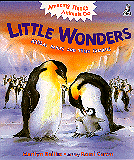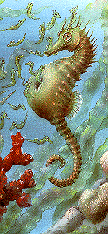

![]()

|
Time to Eat: ISBN: 1-895688-36-1 (cloth) / 1-895688-30-2 (paper).
Subject Headings:
Little Wonders: Subject Headings:
Marilyn Baillie. Illustrated by Romi Caron.
Toronto: Owl Books, 1995 (Distributed by Firefly).
Kindergarten - grade 4 / Ages 5 - 9.
***/4
|
excerpt:
A young male meerkat stands on guard. He sniffs the air for the scent of a fox. He scans the desert sand for the shadow of an eagle's wing. When he's sure there is no danger nearby, a soft chirp and purr from him tells the others, "it's safe." Out of an old termite's nest tumble five playful meerkat kits. Their baby-sitter, a young female, is right at their side. She plays with them and grooms them. The kits suckle milk from her. Some day she might have her own babies. But for now she is much too busy baby-sitting.
THESE TWO TITLES are from the new Owl Books series "Amazing Things Animals Do. . . ." Author Marilyn Baillie and illustrator Romi Caron have produced a pair of books sure to interest children and parents alike.

Baillie, a former
editor of Chickadee Magazine, has edited and compiled previous
science books from Owl. Caron studied painting and drawing in Prague
before emigrating to Canada in 1990. She has worked as an assistant
animator, and created illustrations for the Canadian Museum of Nature.
The text of the
books can be difficult. Words like "predator" and "antennae" mean that
children under ten will probably need help, or will want the books read
to them. But this will be no hardship for the adult reader, as the facts
about animal habits and behaviour are fascinating.

Each book begins
with an illustration with hidden secrets that the reader is challenged to
find, and ends with a quiz about the animals described. (The secrets and
the answers are also given.)
Dr. Katherine E.
Wynne-Edwards of Queens University
served as consultant for the books. This makes it surprising that there
is at least one misleading statement -- the section on the emperor
penguin in Little Wonders says, "There are always some
adult penguins around to keep the chicks . . . safe from animals that
would like to eat them." But there are no land animals in Antarctica
where the emperor penguin lives; there are seals and whales in the ocean
that might prey on penguin chicks, but the reference is to chicks on land. A
comparison of the text with other sources didn't reveal any other
apparent inaccuracies.
Little
Wonders: Animals Babies and Their Families tells of twelve
different animals or birds with strange or amusing ways with their
babies. For example: the sea otter wraps her baby in a strand of kelp to
keep it from drifting away in the ocean; the crocodile mother gently
carries her youngsters to the water in her great mouth; and the
red-billed hornbill hides her babies in a hollow tree with the entrance
plastered over with mud.
Recommended.
Luella Sumner is a librarian in Red Rock, Ontario.
To comment on this title or this review, send mail to cmeditor@mts.net.
![]()
Copyright © 1996 the Manitoba Library Association.
Reproduction for personal use is permitted only if this copyright notice
is maintained. Any other reproduction is prohibited without permission.
Published by
The Manitoba Library Association
ISSN 1201-9364
![]()